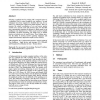Free Online Productivity Tools
i2Speak
i2Symbol
i2OCR
iTex2Img
iWeb2Print
iWeb2Shot
i2Type
iPdf2Split
iPdf2Merge
i2Bopomofo
i2Arabic
i2Style
i2Image
i2PDF
iLatex2Rtf
Sci2ools
ETRA
2010
ACM
2010
ACM
Eye and pointer coordination in search and selection tasks
Selecting a graphical item by pointing with a computer mouse is a ubiquitous task in many graphical user interfaces. Several techniques have been suggested to facilitate this task, for instance, by reducing the required movement distance. Here we measure the natural coordination of eye and mouse pointer control across several search and selection tasks. We find that users automatically minimize the distance to likely targets in an intelligent, task dependent way. When target location is highly predictable, top-down knowledge can enable users to initiate pointer movements prior to target fixation. These findings question the utility of existing assistive pointing techniques and suggest that alternative approaches might be more effective. CR Categories: H.5.2 [Information Interfaces and Presentation]
ETRA 2010 | Eye Tracking Research | Graphical User Interfaces | Mouse Pointer Control | Task Dependent Way |
| Added | 17 May 2010 |
| Updated | 17 May 2010 |
| Type | Conference |
| Year | 2010 |
| Where | ETRA |
| Authors | Hans-Joachim Bieg, Lewis L. Chuang, Roland W. Fleming, Harald Reiterer, Heinrich H. Bülthoff |
Comments (0)

